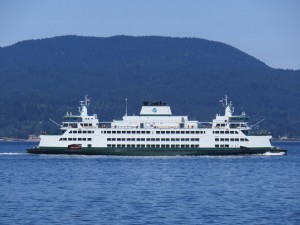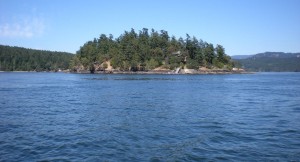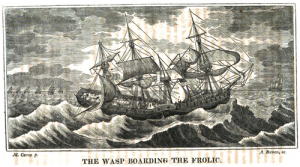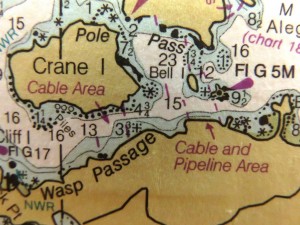A column titled “No Grief on a Reef” caught my eye. Two articles explained how to navigate a boat through Wasp Passage, the narrow channel separating the western tips of Orcas and Shaw islands, and Pole Pass. Both waterways skirt Crane Island, the largest of the Wasp Islands, and are heavily used by marine traffic. Several times each day Washington State ferries, an occasional tug with a log tow, and a myriad of pleasure boats transit Wasp Passage. Only smaller vessels thread their way through Pole Pass.
Washington State ferry
My husband and his friends discovered why the locals nicknamed the Wasp Islands, “the rock pile,” when they ran our sailboat aground about thirty years ago on nearby Bird Rock because of a slight miscalculation in navigation. As recent as 2008, the charter schooner Adventuress repeated the mistake. Click here to read an article and see a photo of their rescue in the same spot and similar to our own. When a high tide is not enough to lift a sailboat off the rocks, powerboat assistance is needed to pull the mast over enough to tilt the underwater keel, allowing the boat to slip off the rocks and into deeper water.
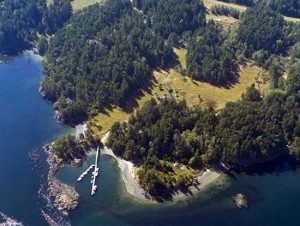
Crane Island’s community dock with the southern entrance to Pole Pass in the lower left corner.
Photo credit: Washington State Dept. of Ecology
Settlers gave Pole Pass its name because Native Americans used to stretch fish nets from poles on either side of the 150-ft wide channel to snare migratory waterfowl. Today, boaters heading north take this shortcut to Deer Harbor on Orcas Island and destinations in the northwest San Juan Islands when the tide and currents are favorable. Once through the pass, on the west side lies Crane Island’s community dock and on the east side is Orcas Island’s community dock. This makes it convenient for the private island’s residents to take the normal Washington State ferry from Anacortes to Orcas Island, drive to the Orcas community dock, load their gear into a small boat, and cross to the Crane Island dock within minutes. Others access their property by private boat or small airplane. Click here to see a short SailingNW.com video of a small sailboat with an outboard engine motoring through the “one boat at a time” channel.
Crane Island looking north from Wasp Passage
The Wasp Islands were named after Wasp, a sloop-of-war commanded by Jacob Jones during the War of 1812, but it’s unclear how Crane Island received its name. Did the author mistake the local Great Blue Herons for Cranes? In 1879, Walter P. Cadwell established a fruit and vegetable farm on the 236-acre island. He lived near Pole Pass until 1906 when he sold the island to John C. Hammond of Seattle. Over the years, lime was quarried from the west side of the island. Other businesses included a pheasantry, sheep ranching, and logging.
Photo credit: Wikimedia Commons
Then in 1960, Island Properties developed and subdivided the island, building the community dock and 1500-ft gravel/grass airstrip. Today, the majority of homes are located around the island’s perimeter along Circle Road. Crane Island Nature Preserve occupies its center. According to the 2010 census, four or five permanent residents live on the island with the rest being part-timers. On a visit to Friday Harbor several years ago, we spotted a classic wood sloop from Crane Island for sale. We were told two women used it for years, sailing to San Juan Island for groceries and supplies. I would’ve enjoyed hearing their tales of life on Crane Island.
Thanks for reading!
Blessings,
Deb

